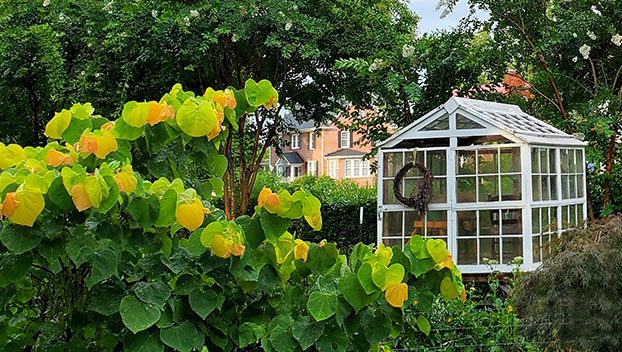Through the Garden Gate: Time to fight against Mother Nature
Published 4:50 pm Friday, May 12, 2023

- This small greenhouse is an example of how materials, such as old windows, can be recycled and repurposed.
|
Getting your Trinity Audio player ready...
|
 Several years ago, I visited the Lost Gardens of Heligan in Cornwall. The gardens were at their peak at the end of the 1800s, and contain one amazing feature after another – rhododendrons from the Himalayas, tree ferns from Australia, a jungle, lakes, a melon house, a stumpery, a rockery, glass houses, and even pineapple pits. It’s a place of superlatives and wonder. By the early 1900s, 22 full time gardeners were required to maintain so many labor-intensive features.
Several years ago, I visited the Lost Gardens of Heligan in Cornwall. The gardens were at their peak at the end of the 1800s, and contain one amazing feature after another – rhododendrons from the Himalayas, tree ferns from Australia, a jungle, lakes, a melon house, a stumpery, a rockery, glass houses, and even pineapple pits. It’s a place of superlatives and wonder. By the early 1900s, 22 full time gardeners were required to maintain so many labor-intensive features.
Sixteen of the gardeners were killed during World War I, and others chose not to return. Society changed, and the gardens fell into ruins and weren’t revived until the 1990s. Heligan was all about man’s ability to bend nature to his will. Why not create manure-heated environments for growing pineapples or prehistoric-looking forests! Just add more labor! Indeed.
We humans have always pitted our will against Mother Nature. Heligan is just one of the most fantastical examples. Today’s world, however, is different. Labor is no longer cheap; gardening jobs aren’t handed down from father to son. Commissioning adventurers to bring back exotic plants from far flung locations is no longer feasible for most individuals either. There are also changes to the environment and our relationship to it that need to be considered. Water is becoming scarce in some areas; there are more extremes in temperatures, animal extinctions are occurring at a rapid rate, and pollinators are threatened. Without them, our food source is threatened.
Trending
The word of the year for gardeners is sustainability. It may sound intimidating, but it’s really all about common sense – using resources wisely for our own enjoyment and the support of other living creatures. Even small tweaks to routine gardening practices can make a difference.
Sustainability means being a smarter gardener — understanding the growing conditions in your area – the type of soil present, the average monthly amount of rainfall, the acidity/alkalinity of the soil, the average date of the first and last frost, typical high and low temperatures, even the appearance of new pests – and knowing how to adjust to them.
Equally important, is having “the right plant in the right place.” Every gardener falls in love with beautiful plants at a garden center and makes an impulse purchase only to discover that the much-desired plants sulk, require huge amounts of pampering, or even die. They’re just not suited to the local growing conditions. Other impulse purchases grow too large for their allotted space and have to be removed. It’s better to weigh the resource requirements of plants before purchasing them.
Related to “the right plant in the right place” is the use of trees and shrubs as windbreaks and to provide shade during hot summers. Careful siting of plants can help reduce the cost of heating and cooling homes. Similarly, the addition of selected native plants to the home garden can reduce the need for pesticides and fertilizer while also providing an energy source for pollinators.
What else to consider? Perhaps slowly reducing the amount of space dedicated to lawn; using fewer herbicides and pesticides; learning to compost kitchen scraps and garden trimmings; recycling pots and other containers; repurposing materials; switching to electric mowers and trimmers; and even learning to live with a few weeds and insects. Just remember that sustainability is a journey; there’s no need to rip everything out of the garden and start afresh. Think about the plants that give you great joy and the amount of time you’re willing to dedicate to gardening. We’ll all different. While I have many native plants in my garden, I wouldn’t want to eliminate my much loved daylilies, irises, and hellebores.
Happy gardening!
Trending
DR. CYNTHIA WOOD is a master gardener. Her email address is cynthia.crewe23930@gmail.com.





